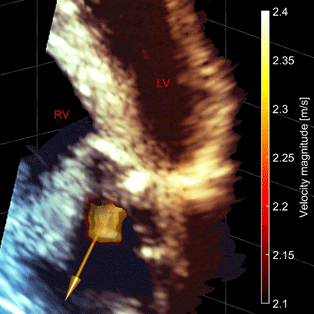Aortic valve stenosis is a narrowing of the valve that separates the left ventricle from the aorta. A reduced opening increases the effort required by the left ventricle to pump blood. Being a degenerative disease, patients with aortic stenosis must undergo a clinical follow-up, which is usually performed by ultrasound. At the Centre of Innovative Ultrasound Solutions (CIUS), we are developing a new method that exploits 3-D high frame-rate imaging to increase the degree of automation in aortic stenosis flow measurements. The goal is to speed up the workflow in the clinics and increase the accuracy of measurements.
CIUS
-
How do you check that a petroleum well is leak-proof, so that it cannot endanger the environment or the platform staff? To do so, you’d have to investigate a narrow hole with a diameter of maybe 30 cm, kilometers below the ground, where the temperatures can reach well above 100°C and the pressure is crushing. This may sound difficult, and it is! Even so, the petroleum industry has been doing things like these for almost a century, and over the past four decades they have increasingly been using ultrasonic techniques.
-
CardiovascularNTNUhealth
Improving cardiac ultrasound in difficult-to-image patients
by @NTNUhealth 30 August 2018Despite constant improvements within the field of medical ultrasound, there are still a considerable number of difficult-to-image patient. Echocardiograms (heart images) taken from these patients do not have the quality that is needed for correct diagnosis. Therefore it is important to further improve the quality of echocardiograms.
-
CardiovascularNTNUhealth
Could your local doctor diagnose heart disease using a handheld ultrasound device?
by @NTNUhealth 29 June 2018Many potential heart patients that are referred to specialists, turn out not to need specialist care. If general practitioners (GPs) could use handheld ultrasound devices with built-in diagnostic tools, could this improve patient outcome and reduce cost for the health services?
-
CardiovascularNTNUhealth
Improving ultrasound images of the heart’s blood vessels
by @NTNUhealth 20 June 2018Coronary heart disease is a condition where the heart muscle (myocardium) does not receive enough oxygen and nutrients due to obstruction of blood flow in the heart’s blood vessels, known as the coronary arteries. It is therefore important to investigate the blood flow in these vessels. However, it is challenging to obtain accurate measurements due to the combination of poor blood flow, the constant movement of the heart throughout the cardiac cycle, and surrounding tissue causing noise signals.
-
CardiovascularNTNUhealth
Using artificial intelligence to measure the heart
by @NTNUhealth 24 May 2018Artificial intelligence can now help clinicians by automatically measuring the heart in ultrasound images. This can save time and may in the future enable inexperienced users to perform accurate measurements of the heart.
-
NTNUhealthResearch
Making analog-to-digital converters for digital ultrasound probes
by @NTNUhealth 19 April 2018Making good digital ultrasound probes is extremely challenging because of the constrained amount of power that can be used. If significantly more than a couple of watts are consumed, the probe gets too hot to be allowed to touch your skin.
-
Increased availability of ultrasound devices is great news, but it also triggers a range of new challenges. At CIUS we believe modern machine learning methods, such as deep learning, can provide necessary solutions.
-
NTNUhealth
Optimization of transmit ultrasound pulses in second harmonic imaging
by @NTNUhealth 14 March 2018Today, second harmonic imaging is a preferred ultrasound imaging modality, mainly due to its ability to improve image quality by suppressing undesired acoustic reverberations. This imaging modality improves the diagnostics for different medical applications, and most of the cardiac ultrasound scanners in the hospitals use this method. We have established an experimental measurement system to measure, manipulate, and optimize excitation waveforms, and one of the goals is to reduce the undesired transmitted signal.
-
NTNUhealth
Can hybrid PET/MRI improve the diagnostic accuracy of brain glioma?
by @NTNUhealth 8 February 2018Gliomas are the most common primary brain tumors in adults with an incidence of around 250 cases per year in Norway. The outcome is poor, and the diagnostic accuracy is essential to estimate overall prognosis and to plan the best treatment for the patient. Can a hybrid PET/MRI system improve the diagnostic accuracy and treatment planning for this patient group?

